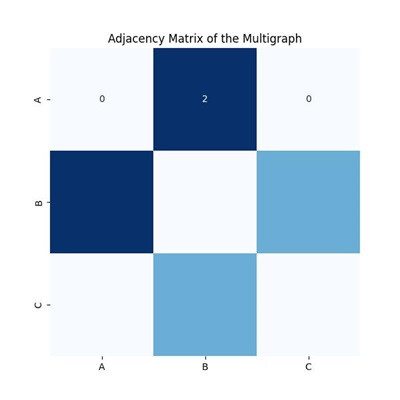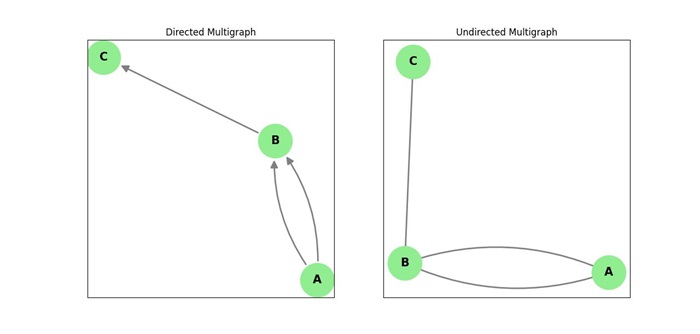
- Graph Theory - Home
- Graph Theory - Introduction
- Graph Theory - History
- Graph Theory - Fundamentals
- Graph Theory - Applications
- Types of Graphs
- Graph Theory - Types of Graphs
- Graph Theory - Simple Graphs
- Graph Theory - Multi-graphs
- Graph Theory - Directed Graphs
- Graph Theory - Weighted Graphs
- Graph Theory - Bipartite Graphs
- Graph Theory - Complete Graphs
- Graph Theory - Subgraphs
- Graph Theory - Trees
- Graph Theory - Forests
- Graph Theory - Planar Graphs
- Graph Theory - Hypergraphs
- Graph Theory - Infinite Graphs
- Graph Theory - Random Graphs
- Graph Representation
- Graph Theory - Graph Representation
- Graph Theory - Adjacency Matrix
- Graph Theory - Adjacency List
- Graph Theory - Incidence Matrix
- Graph Theory - Edge List
- Graph Theory - Compact Representation
- Graph Theory - Incidence Structure
- Graph Theory - Matrix-Tree Theorem
- Graph Properties
- Graph Theory - Basic Properties
- Graph Theory - Coverings
- Graph Theory - Matchings
- Graph Theory - Independent Sets
- Graph Theory - Traversability
- Graph Theory Connectivity
- Graph Theory - Connectivity
- Graph Theory - Vertex Connectivity
- Graph Theory - Edge Connectivity
- Graph Theory - k-Connected Graphs
- Graph Theory - 2-Vertex-Connected Graphs
- Graph Theory - 2-Edge-Connected Graphs
- Graph Theory - Strongly Connected Graphs
- Graph Theory - Weakly Connected Graphs
- Graph Theory - Connectivity in Planar Graphs
- Graph Theory - Connectivity in Dynamic Graphs
- Special Graphs
- Graph Theory - Regular Graphs
- Graph Theory - Complete Bipartite Graphs
- Graph Theory - Chordal Graphs
- Graph Theory - Line Graphs
- Graph Theory - Complement Graphs
- Graph Theory - Graph Products
- Graph Theory - Petersen Graph
- Graph Theory - Cayley Graphs
- Graph Theory - De Bruijn Graphs
- Graph Algorithms
- Graph Theory - Graph Algorithms
- Graph Theory - Breadth-First Search
- Graph Theory - Depth-First Search (DFS)
- Graph Theory - Dijkstra's Algorithm
- Graph Theory - Bellman-Ford Algorithm
- Graph Theory - Floyd-Warshall Algorithm
- Graph Theory - Johnson's Algorithm
- Graph Theory - A* Search Algorithm
- Graph Theory - Kruskal's Algorithm
- Graph Theory - Prim's Algorithm
- Graph Theory - Borůvka's Algorithm
- Graph Theory - Ford-Fulkerson Algorithm
- Graph Theory - Edmonds-Karp Algorithm
- Graph Theory - Push-Relabel Algorithm
- Graph Theory - Dinic's Algorithm
- Graph Theory - Hopcroft-Karp Algorithm
- Graph Theory - Tarjan's Algorithm
- Graph Theory - Kosaraju's Algorithm
- Graph Theory - Karger's Algorithm
- Graph Coloring
- Graph Theory - Coloring
- Graph Theory - Edge Coloring
- Graph Theory - Total Coloring
- Graph Theory - Greedy Coloring
- Graph Theory - Four Color Theorem
- Graph Theory - Coloring Bipartite Graphs
- Graph Theory - List Coloring
- Advanced Topics of Graph Theory
- Graph Theory - Chromatic Number
- Graph Theory - Chromatic Polynomial
- Graph Theory - Graph Labeling
- Graph Theory - Planarity & Kuratowski's Theorem
- Graph Theory - Planarity Testing Algorithms
- Graph Theory - Graph Embedding
- Graph Theory - Graph Minors
- Graph Theory - Isomorphism
- Spectral Graph Theory
- Graph Theory - Graph Laplacians
- Graph Theory - Cheeger's Inequality
- Graph Theory - Graph Clustering
- Graph Theory - Graph Partitioning
- Graph Theory - Tree Decomposition
- Graph Theory - Treewidth
- Graph Theory - Branchwidth
- Graph Theory - Graph Drawings
- Graph Theory - Force-Directed Methods
- Graph Theory - Layered Graph Drawing
- Graph Theory - Orthogonal Graph Drawing
- Graph Theory - Examples
- Computational Complexity of Graph
- Graph Theory - Time Complexity
- Graph Theory - Space Complexity
- Graph Theory - NP-Complete Problems
- Graph Theory - Approximation Algorithms
- Graph Theory - Parallel & Distributed Algorithms
- Graph Theory - Algorithm Optimization
- Graphs in Computer Science
- Graph Theory - Data Structures for Graphs
- Graph Theory - Graph Implementations
- Graph Theory - Graph Databases
- Graph Theory - Query Languages
- Graph Algorithms in Machine Learning
- Graph Neural Networks
- Graph Theory - Link Prediction
- Graph-Based Clustering
- Graph Theory - PageRank Algorithm
- Graph Theory - HITS Algorithm
- Graph Theory - Social Network Analysis
- Graph Theory - Centrality Measures
- Graph Theory - Community Detection
- Graph Theory - Influence Maximization
- Graph Theory - Graph Compression
- Graph Theory Real-World Applications
- Graph Theory - Network Routing
- Graph Theory - Traffic Flow
- Graph Theory - Web Crawling Data Structures
- Graph Theory - Computer Vision
- Graph Theory - Recommendation Systems
- Graph Theory - Biological Networks
- Graph Theory - Social Networks
- Graph Theory - Smart Grids
- Graph Theory - Telecommunications
- Graph Theory - Knowledge Graphs
- Graph Theory - Game Theory
- Graph Theory - Urban Planning
- Graph Theory Useful Resources
- Graph Theory - Quick Guide
- Graph Theory - Useful Resources
- Graph Theory - Discussion
Graph Theory - Multigraphs
Multigraph
A multigraph is a type of graph that allows multiple edges between the same pair of vertices. These multiple edges are also called parallel edges. In a multigraph, an edge can appear more than once between two vertices, representing different connections or relationships.
In a simple graph, we restrict the number of edges between any two vertices to be one, and no loops (edges connecting a vertex to itself) are allowed. In contrast, multigraphs allows multiple edges and loops, which makes them more flexible for modeling complex relationships.
Multigraphs are useful in various applications like transportation networks, communication systems, and complex social networks, where multiple relationships between the same entities can exist simultaneously.
This tutorial will cover different aspects of multigraphs, including their definition, types, properties, and applications.
Example
Consider a graph with vertices V = {A, B, C, D} and edges E = {(A, B), (A, B), (A, D), (A, D), (A, C), (B, D)}. This graph is a multigraph because −
- There are multiple edges between A and B & A and D (parallel edges).
- There are no restrictions on the number of edges between any two vertices.

Representation of Multigraphs
Multigraphs can be represented in various ways, similar to simple graphs. However, since multigraphs may have multiple edges between the same pair of vertices, special attention must be given to their representation.
Adjacency Matrix Representation
The adjacency matrix for a multigraph is a square matrix where each element represents the number of edges between the corresponding vertices. Instead of using just 0 or 1 to denote the presence or absence of an edge, the matrix will contain the number of parallel edges between any two vertices.
Example
Consider the multigraph with vertices A, B, C and edges E = {(A, B), (A, B), (B, C)}. The adjacency matrix would look like this −
| A | B | C | |
| A | 0 | 2 | 0 |
| B | 2 | 0 | 1 |
| C | 0 | 1 | 0 |
This matrix indicates that −
- There are 2 edges between A and B.
- There is 1 edge between B and C.
- There are no edges between A and C.

Adjacency List Representation
In the adjacency list representation of a multigraph, each vertex is associated with a list of edges that connect it to other vertices. Instead of just listing each adjacent vertex once, we count the number of times each vertex appears in the list to represent multiple edges.
Example
For the multigraph with vertices A, B, C and edges E = {(A, B), (A, B), (B, C)}, the adjacency list representation would be −
- A: [B, B]
- B: [A, C]
- C: [B]
Degree of a Vertex in Multigraphs
The degree of a vertex in a multigraph is the number of edges incident to it, considering multiple edges as well. If multiple edges exist between two vertices, they are counted as separate edges for degree calculation.
- The degree of a vertex v, denoted deg(v), is the sum of the number of edges incident to v.
- In a multigraph, an edge between two vertices is counted for both vertices.
Types of Degree
The types of degree in a multigraph are similar to those in simple graphs −
- In-degree: The number of edges directed towards a vertex (used in directed multigraphs).
- Out-degree: The number of edges directed away from a vertex (also used in directed multigraphs).
Example
For the multigraph with vertices A, B, C and edges E = {(A, B), (A, B), (B, C)}, the degree of each vertex is:
- deg(A) = 2 (since there are two edges from A to B)
- deg(B) = 3 (two edges from A to B and one edge from B to C)
- deg(C) = 1 (one edge from B to C)

Properties of Multigraphs
Multigraphs have some unique properties due to the presence of multiple edges between vertices. These properties help distinguish multigraphs from simple graphs and provide a better understanding of their structure.
Multiple Edges
In a multigraph, multiple edges (parallel edges) between the same pair of vertices are allowed. This is one of the key differences between multigraphs and simple graphs, where only one edge between any two vertices is allowed.
Loops
In a multigraph, loops (edges that connect a vertex to itself) are also allowed. This is another important distinction from simple graphs, where loops are not allowed.
Maximal Number of Edges
For a multigraph with n vertices, there is no upper bound on the number of edges that can exist between any two vertices, as long as multiple edges and loops are allowed. The total number of edges in the graph depends on the number of parallel edges between vertices.
Directed and Undirected Multigraphs
Multigraphs can be either directed or undirected, and this influences the structure of the graph −
- Directed Multigraphs: The edges have a direction, meaning that each edge has a starting and ending vertex.
- Undirected Multigraphs: The edges have no direction, meaning the relationship between the two vertices is symmetric.

Subgraphs in Multigraphs
A subgraph of a multigraph is a graph formed by selecting a subset of vertices and edges from the original graph. A subgraph in a multigraph can include multiple edges between vertices or even loops.

Applications of Multigraphs
Multigraphs are used in various real-life applications where relationships between entities are complex and multiple interactions can exist between the same pair of entities. Here are some key applications −
Transportation Networks
In transportation systems, multiple routes can exist between the same two locations. A multigraph can model these situations, where the vertices represent locations, and the edges represent different routes between locations.
Communication Networks
Communication systems often have multiple communication channels between the same pair of devices. A multigraph can represent these systems by allowing multiple edges between the same pair of devices.
Social Networks
In social networks, individuals can have multiple types of relationships with each other. A multigraph can model these relationships by allowing multiple edges between two individuals, each representing a different type of relationship (e.g., friendship, professional connection, etc.).
Routing and Optimization Problems
Multigraphs are used to model problems like packet routing in networks, where multiple routes between nodes are available. The multiple edges represent different paths or communication links between nodes, making it easier to find the optimal path.